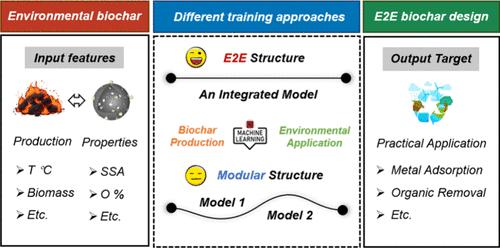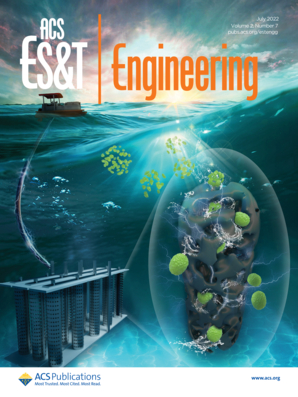Machine Learning toward Realizing End-to-End Biochar Design for Environmental Remediation
IF 7.4
Q1 ENGINEERING, ENVIRONMENTAL
引用次数: 0
Abstract
Developing algorithmic methodologies for the rational design of environmental functional materials enables targeted approaches to environmental challenges. Novel machine learning (ML) tools are instrumental in realizing this goal, particularly when biochars are involved with complex components and flexible internal structures. However, such rational design necessitates a holistic perspective across the entire multistage design process, while current ML endeavors for environmental biochar (EB) often concentrate on specific production or application substages. In this regard, taking an end-to-end (E2E) approach to applying ML holds the potential to better guide EB design from a comprehensive view, a perspective yet to be thoroughly explored and summarized. Thus, we review the recent advancements of ML employed in predicting EB problems, aiming to elucidate the broad relevance of various ML models in realizing the E2E design of EBs. It is observed that the properties of EB might be the “Achilles’ heel” within the data set, which poses a significant challenge to achieving the E2E. Furthermore, we also provide an overview of the existing pathways to achieve the E2E, examining both traditional ML and the emerging field of deep leaning, followed by a discussion on key challenges, opportunities, and our vision for the future of rational EB design.

通过机器学习实现用于环境修复的端到端生物炭设计
为合理设计环境功能材料开发算法方法,可以有针对性地应对环境挑战。新颖的机器学习(ML)工具有助于实现这一目标,尤其是当生物炭涉及复杂的成分和灵活的内部结构时。然而,这种合理的设计需要在整个多阶段设计过程中采用整体视角,而目前针对环境生物炭(EB)的机器学习努力往往集中在特定的生产或应用子阶段。因此,采用端到端(E2E)的方法来应用 ML 有可能更好地从全面的角度指导 EB 设计,而这一观点还有待深入探索和总结。因此,我们回顾了最近在预测 EB 问题时使用的 ML 的最新进展,旨在阐明各种 ML 模型在实现 E2E EB 设计中的广泛相关性。据观察,EB 的特性可能是数据集中的 "致命弱点",这对实现 E2E 构成了重大挑战。此外,我们还概述了实现 E2E 的现有途径,研究了传统 ML 和新兴的深度倾斜领域,随后讨论了合理 EB 设计的关键挑战、机遇和我们对未来的展望。
本文章由计算机程序翻译,如有差异,请以英文原文为准。
求助全文
约1分钟内获得全文
求助全文
来源期刊

ACS ES&T engineering
ENGINEERING, ENVIRONMENTAL-
CiteScore
8.50
自引率
0.00%
发文量
0
期刊介绍:
ACS ES&T Engineering publishes impactful research and review articles across all realms of environmental technology and engineering, employing a rigorous peer-review process. As a specialized journal, it aims to provide an international platform for research and innovation, inviting contributions on materials technologies, processes, data analytics, and engineering systems that can effectively manage, protect, and remediate air, water, and soil quality, as well as treat wastes and recover resources.
The journal encourages research that supports informed decision-making within complex engineered systems and is grounded in mechanistic science and analytics, describing intricate environmental engineering systems. It considers papers presenting novel advancements, spanning from laboratory discovery to field-based application. However, case or demonstration studies lacking significant scientific advancements and technological innovations are not within its scope.
Contributions containing experimental and/or theoretical methods, rooted in engineering principles and integrated with knowledge from other disciplines, are welcomed.
 求助内容:
求助内容: 应助结果提醒方式:
应助结果提醒方式:


